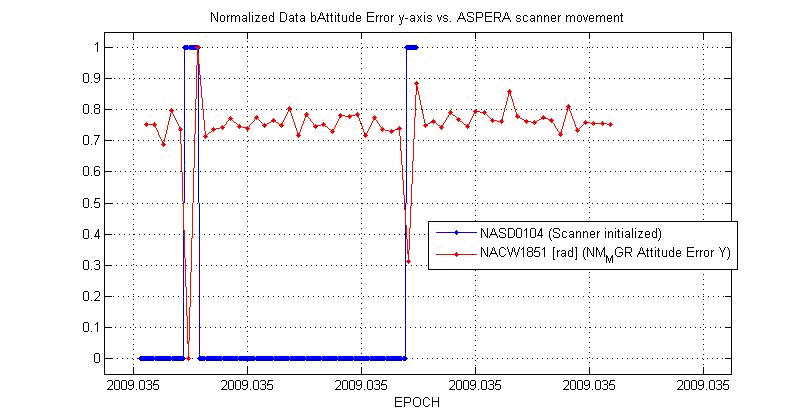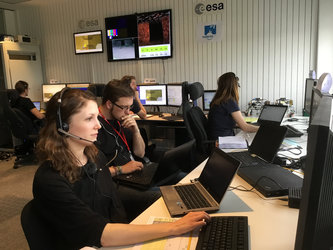DrMUST
Automating the first steps of Anomaly Investigation
Once engineers have realised that an anomaly has happened, they face the problem of identifying the possible causes and other effects of this anomaly. DrMUST performs pattern matching to find similar behaviours across history (years) and correlation analysis to find which other parameters (out of 20 000) are involved in a given anomaly. DrMUST can be used not only for anomaly investigation but also to perform characterisations.
Keywords: monitoring, diagnostics, performance analysis
Results
DrMUST is currently used by Venus Express and Planck both for pattern matching and correlation analysis. Flight Control Team reports 20% – 30% effort reduction in performing anomaly investigation (the other 70% - 80% effort is taken by taking corrective and preventive actions such as modifying procedures).
Technology
DrMUST uses speech recognition techniques to find similar patterns in order to cope with small deviations in the behaviour (in the same sense that the same word is spoken differently by two different speakers). Regarding the correlation analysis we have developed a robust technique that finds which parameters are somehow involved in a specific situation (e.g. anomaly, characterisation). The ESA Patent Group has decided to protect DrMUST by filing a patent application in the European Patent Office.
Development Team
DrMUST has been developed by our group.
Description
Anomaly investigation is part of the routine diagnostic task of flight control engineers. When an anomaly is detected (e.g. when a particular parameter crosses a noticeable threshold), it is common practise to search along the telemetry history for similar behavioural patterns in order to characterise the anomaly. By analysing the time periods when the anomaly happened in the past, we may be able to identify its causes and eventually prevent it from happening again in the future. The anomaly investigation process can be very labour intensive: many different parameters need to be analysed to identify possible correlations with the observed anomaly.
Although DrMUST has been designed with the goal of supporting anomaly investigation; it can also be used to perform system or subsystem characterisation. This process helps engineers in identifying potential areas of concern when operating the spacecraft in different modes.
Dr. MUST offers two main functionalities:
- Pattern Matching finds similar patterns in a given telemetry parameter from a large time period (in the order of years). When an anomaly is noticed, it is useful to understand if it is really a new anomaly or if it happened before (and went unnoticed). The Pattern Matching functionality of DrMUST finds when similar behaviours happened in the history of a certain parameter. Since behaviours are never exactly the same, the Pattern Matching functionality needs to allow for certain flexibility to recognise similar behaviour. The enabling technology is the usage of speech recognition techniques as they recognise the same word even if spoken by different speakers.
- Correlator finds the telemetry parameters that are involved in a relevant time period (e.g. anomaly) from a large number of parameters (in the order of tens of thousands). In order to find which parameters are correlated, the following assumptions are made: 1. parameters related to the anomaly behave similarly in all same-anomaly periods; 2. parameters related to the anomaly will behave differently during anomaly and nominal periods. The solving approach consists of scanning every parameter and suggesting to the users those parameters with a similar behaviour during anomaly periods and different behaviour during nominal periods.

This is the Venus Express flight control team operational assessment:
- Allows “googling” through spacecraft data: searching of similar occurrences or correlated occurrences.
- Impressive performance: queries run very quickly compared to manual searches.
- DrMUST assists in data analysis tasks which are very labour intensive. Before, it was required that the engineer would guess or hypothesise which parameters could have a credible correlation to a specific behaviour and then would perform the analysis to prove it or discard the correlation. DrMUST finds these correlations for the engineer even the ones he had not thought about.
Dr. MUST is a MUST Client in the sense that it uses time series data provided by the MUST repository. However, it can be easily adapted to work with any kind of time series data.
Publications
- Martinez-Heras, J.A., Yeung, K., Donati, A., Sousa, B., Keil, N.; DrMUST: Automating the Anomaly Investigation First-Cut. In the IJCAI-09 Workshop on Artificial Intelligence in Space. Pasadena, California, USA, July 17 - 18, 2009








